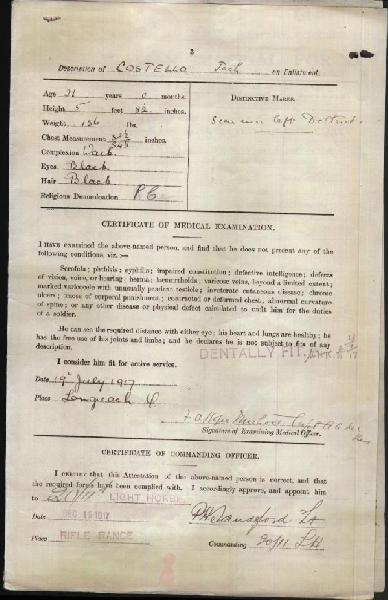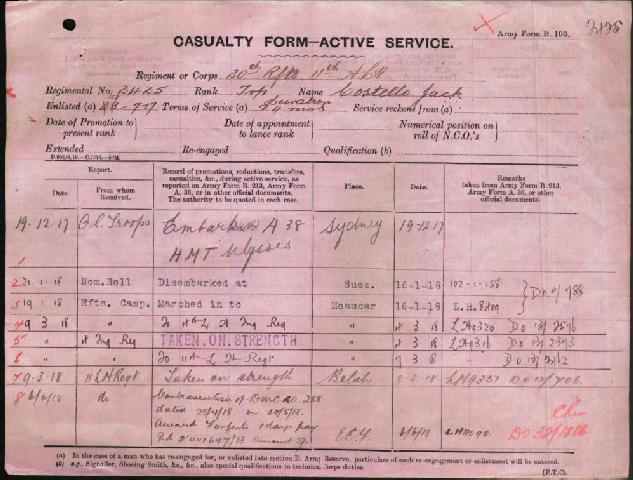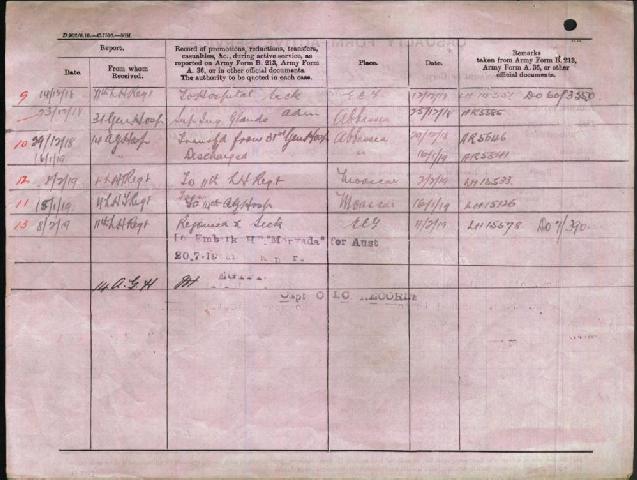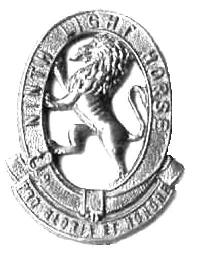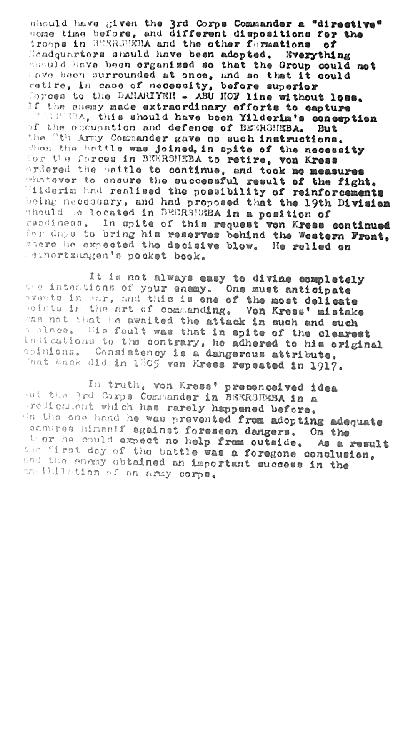Topic: AIF - Aboriginal LH
Education Centre
The Australian Light Horse Studies Centre in conjunction with the various Education authorities in Australia, has embarked upon producing a program of instruction targeted initially towards the Later Adolescence band of scholars, characteristically those who are studying in Year 9 and 10 within Australia. Each lesson will be a self contained module. Some will be more difficult than others and graded accordingly.
Lesson 11 Aboriginal Light Horsemen
Resource - Light Horseman Service Record - Essential Pages
2425 Pte Jack Costello, 11th Light Horse Regiment, 20th Reinforcement
[Click on document for larger version.]
The front cover of the Attestation Paper of Persons Enlisted for Service Abroad provides the reader with the following information:
- Service Number,
- Surname,
- Given Names,
- Age,
- Employment,
- Married or Single,
- Next of Kin Relationship,
- Next of Kin Name and Address,
- Enlistment Date.
This information is vital as it identifies the specific soldier and in case of death or injury, allows the relatives to be informed. The next of kin was important for another reason. Each soldier was compelled to give an allotment of their daily wage to the person nominated as the next of kin. This was an essential financial consideration.
Once this information was gathered, the second page dealt with an oath to the King. The next page to give information was page 3.
[Click on document for larger version.]
The third page of the Attestation Paper of Persons Enlisted for Service Abroad provides the reader with the following information:
- Age,
- Height,
- Weight,
- Chest Measurement
- Complexion,
- Eyes,
- Hair,
- Religion.
The health of the potential soldier was important as the life was particularly strenuous. The ability to carry heavy weights for great distances was most important.
The next form that is most common in the Service File is the B103, the Casualty Form - Active Service. Every movement of the soldier is recorded. The reasons for this are fourfold.
1. The location of the soldier at any one time was essential to establish where his rations were to be drawn.
2. The form established the entitlements to drawing pay at a particular level. A soldier in the field was allowed to draw pay but when in hospital was not allowed to draw their pay as it was considered that everything to assist the soldier's recovery was provided.
3. By tracking the movements of the soldier, it allowed early detection of desertion if that were to occur.
4. At the end of the war, the chronology of this form was used as the basis for post war entitlements such as medals, pensions, repatriation assistance, access to hospitals and any other service available for an ex-serviceman for the rest of his life.
The B103 may be as simple as one sheet or multiple sheets. It depended upon the individual serviceman.
To assist in understanding this particular form in relation to the men from the 11th LHR, Lesson 11 Resource, a list of terms and names are available at the Index to Common B103 Terms. The link is below.
[Click on document for larger version.]
The front of the B103, the Casualty Form - Active Service provides the reader with the following information:
- Regiment
- Rank on Enlistment,
- Terms of Enlistment,
- Embarkation Date,
- Embarkation Port,
- Embarkation Ship,
- Date Taken on Strength.
As can be seen, the form is a chronology of the man's service in the AIF. All B103 forms in every service file is similar.
In this case the man has two pages to the form. To finish his story, the page will be turned over.
[Click on document for larger version.]
The back of the B103, the Casualty Form - Active Service provides the reader with the following information:
- Chronology,
- Fate,
- Date.
Once the B103, the Casualty Form - Active Service was completed due to the expiration of service, any transactions during subsequent to service were recorded on a flimsey called Transferred to Australian Imperial Force D and it was here that all post service information was maintained.
[Click on document for larger version.]
Page 1 of the Transferred to Australian Imperial Force D provides the reader with the following information:
- The last rank held in the AIF,
- The date of Discharge,
- The place where Discharged,
- The eligible medals awarded to the serviceman.
Information on this form depends upon the individual. This particular form can at times run into many pages.
2425 Pte Jack Costello, a brief military biography from The AIF Project:
Jack COSTELLO
| Regimental number | 2425 |
| Religion | Roman Catholic |
| Occupation | Stockman |
| Address | Winton, Queensland |
| Marital status | Single |
| Age at embarkation | 21 |
| Next of kin | Friend, T H Snelling, c/o Q N Bank, Queen Street, Brisbane, Queensland |
| Enlistment date | 19 July 1917 |
| Rank on enlistment | Private |
| Unit name | 11th Light Horse Regiment, 20th Reinforcement |
| AWM Embarkation Roll number | 10/16/3 |
| Embarkation details | Unit embarked from Sydney, New South Wales, on board HMAT A38 Ulysses on 19 December 1917 |
| Rank from Nominal Roll | Private |
| Unit from Nominal Roll | 4th Light Horse Regiment |
| Fate | Returned to Australia 20 July 1919 |
Additional Research:
To understand the terms employed in the B103, the Casualty Form - Active Service, an index is available here:
For those interested in further study on this man, the following internet resources are available:
ADFA Summary - This is a cameo summary of his service record.
http://www.aif.adfa.edu.au:8080/showPerson?pid=63536
National Archives - This is the complete service file of 2425 Pte Jack Costello
http://naa12.naa.gov.au/scripts/imagine.asp?B=3426414&I=1&SE=1
Australian War Memorial
The Australian War Memorial carries two biographical data bases - the Embarkation Roll and the Nominal Roll which was closed in August 1919.
Embarkation details:
http://www.awm.gov.au/nominalrolls/ww1/embarkation/person.asp?p=42543
Nominal Roll:
http://www.awm.gov.au/cms_images/awm133/11/11-058.pdf
Further Reading:
Other Aboriginal Servicemen
2919 Pte Alfred John Henry Lovett
Other related items
Reveille Articles on Aboriginals in the AIF
11th Light Horse War Diary Index for 1918 - 1919, Lesson 11 Resource
11th LHR, AIF account about the 2nd Es Salt Raid - March to May 1918, Chapter XVI
11th LHR, AIF account about the Jordan Valley – May to August 1918, Chapter XVII
Citation: 2425 Pte Jack Costello, 11th LHR, Lesson 11 Resource




